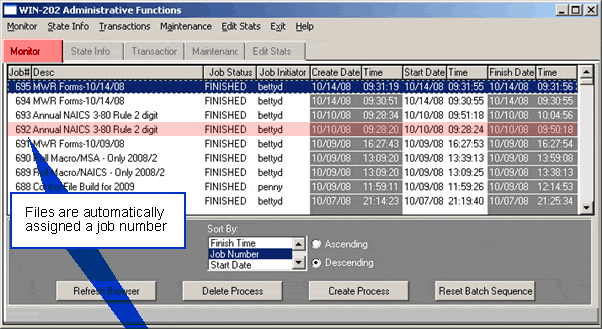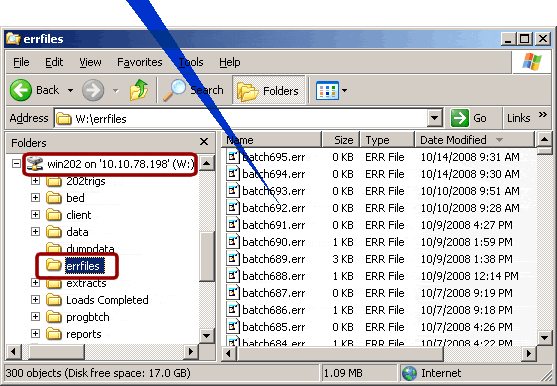Create Process: Ad Hoc Programs
The system contains ad hoc procedures you can run to get answers for a specific question. These programs are stored on the server under the \win202\progbtch directory.
To Run a Program:
- Click the [Create Process] button from the Monitor tab to bring up the "Run Adhoc Process" screen.
- Enter a program name including the file extension in the Program Name field.
- Enter a description of the job you want to run in the Job Description field.
- Enter a set of parameters in the Job Parameters field. If there are no parameters leave this blank.
- Click [OK] to run the job. If you click the [Cancel] button the job does not run.
Note: You must know what the parameters are and the order they are in. Separate each parameter with a comma. Parameters are specific to the job you are running.
The output from an ad hoc program is stored in the \Win202\reports directory on the server. An error file is created for each job and the job number is part of the filename. Error files are written to the \win202\errfiles directory on your server. If a job fails, you can look at error files for possible causes. Certain error files may contain information such as the number of records processed.
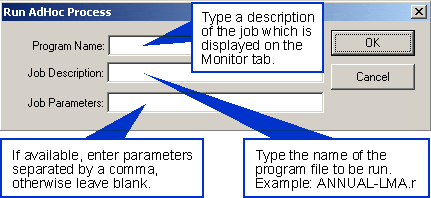
ARCS Selection Criteria (Control File Build)
The selection of accounts for the Annual Refiling Survey (ARS) is done via an ad hoc procedure to create the "Control File". Note: the ARCS Lookup Tab on the Quarterly Processing screen allows you to view the contents of the Control file (see Chapter 5, Lookup Tables, ARCS Lookup Tab for more information).
Control File Build:
- Click the [Create Process] button from the Monitor tab to bring up the "Run Adhoc Process" screen shown below.
- Enter the program name: cfbfyYYYY.r
- Enter the job description: CFB YYYY
- Leave parameters blank
- Click [OK] to run the job
- View the progress via the Batch Monitor

The following 5 output files are placed in the \win202\reports directory:
- cfb2009-trs.txt: A file containing single accounts that are TRS eligible. This file is sent to BLS to create a TRS Respondent file to be used with the TRS Load.
- cfb2009-invalidcty.txt: A list of accounts with invalid County codes for the current quarter.
- cfb2009-ein.txt: A report containing a list of accounts that were automatically assigned a Response Code of 41 based on the list of EINs supplied by BLS National Office.
- cfb2009-ars-total.txt: A summary information report for review by the State and Regional office. This report helps States understand the contents of the control file so they can avoid any problems when building it. It contains information on counts of masters, singles, and subunits for each EIN pair (e.g., 33,34,…66) and totals; counts of masters, singles and subunits with zero or invalid EINs (this count also shows which position of the UI account number field was used to select the records); counts of masters, singles and subunits by size with totals; counts of TRS eligible records; and counts of carryover records.
- trs-listing-2009.txt: A count of individual Collection Mode Indicators (CMI) for non-respondents. This listing can also be run from the Reports Screen (Control File Listing for Non-Respondents).
After you have completed the control file build, go to the "Reports Screen" and run the "ARCS Forms ... VS, VM" report from the "Reports Tab" (see Chapter 7 for more information on running reports). The files (vmtp, vstp, and vs-trs-tp) are generated in the \win202\reports directory. Note: If you are centrally printing your forms (CARS), you must change Parm Value 019 to 1 (yes) on the "Report Params Tab" to turn on the CARS option and change the print output for the forms (see figures below ).
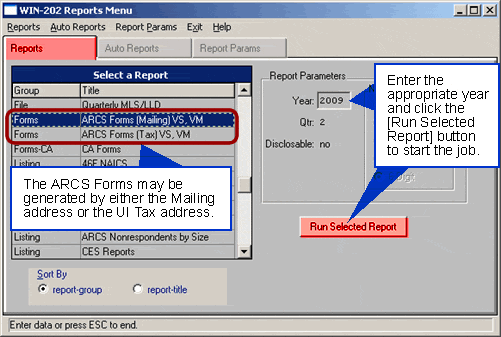
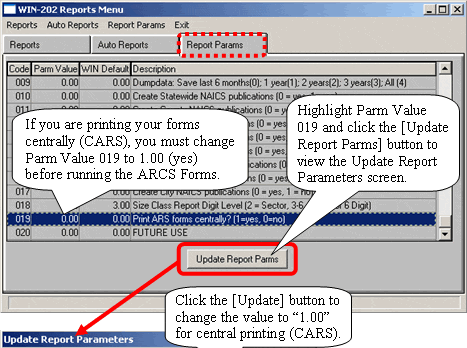
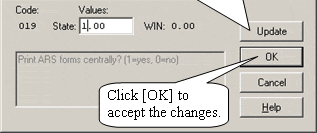
Error File
For each load/batch that is run, an error file is produced in the /win202/errfiles folder. Each file name is automatically assigned a batch job number that can be viewed on the "Monitor" screen. In the example shown below, job numbers 688 through 695 on the "Monitor" screen correspond to the error files produced in the Error Files folder (errfiles). Note: File sizes of 0 KB indicate that there are no errors. These files are blank and cannot be opened.
